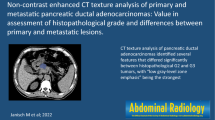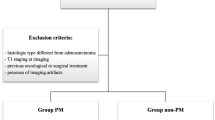Abstract
Purpose
To develop a predictive model for liver metastases in patients with pancreatic ductal adenocarcinoma (PDAC) based on textural features of the primary tumor extracted by computed tomography (CT) images.
Materials and methods
Patients with a pathologically proved PDAC who underwent CT between December 2020 and January 2022 were retrospectively identified. Treatment-naïve patients were included. Sex, age, tumor size, vascular infiltration and 39 arterial and portal phase textural features were analyzed. The variables significantly correlated to tumor size according to the Pearson's product-moment correlation test were excluded from analysis; the remaining variables were compared between metastatic (M +) and non-metastatic (M−) patients using Fisher’s or Mann–Whitney test. The features with a significant difference between groups were entered into a binomial logistic regression test to develop a predictive model for liver metastases.
Results
This study included 220 patients. Eight variables (tumor size, arterial HU_MAX, arterial GLRLM_LRLGE, arterial GLZLM_SZHGE, arterial GLZLM_LZLGE, portal GLCM_CORRELATION, portal GLRLM_LRLGE, and portal GLZLM_SZHGE) were significantly different between groups. The logistic regression model was statistically significant (χ2 = 81.6, p < .001) and correctly classified 80.9% of cases. Sensitivity, specificity, positive and negative predictive values of the model were 58.6%, 91.3%, 75.9% and 82.5%, respectively. The area under the ROC curve of the model was 0.850 (95% CI, 0.793–0.907). Tumor size, arterial HU_MAX, arterial GLZLM_SZHGE and portal GLCM_CORRELATION were significant predictors of the likelihood of liver metastases, with odds ratios of 1.1, 0.9, 1, and 1.49, respectively.
Conclusions
CT texture analysis of PDAC can identify features that may predict the likelihood of liver metastases.


Similar content being viewed by others
References
Rawla P, Sunkara T, Gaduputi V (2019) Epidemiology of pancreatic cancer: global trends, etiology and risk factors. World J Oncol 10:10–27
Carioli G, Malvezzi M, Bertuccio P, Boffetta P, Levi F, La Vecchia C, Negri E (2021) European cancer mortality predictions for the year 2021 with focus on pancreatic and female lung cancer. Ann Oncol 32:478–487. https://doi.org/10.1016/j.annonc.2021.01.006
Associazione Italiana di Oncologia Medica (2021) Linee guida Carcinoma del pancreas esocrino. https://www.aiom.it/linee-guida-aiom-2021-carcinoma-del-pancreas-esocrino/ Accessed 7 Jul 2022
Rebelo A, Büdeyri I, Heckler M, Partsakhashvili J, Ukkat J, Ronellenfitsch U, Michalski CW, Kleeff J (2020) Systematic review and meta-analysis of contemporary pancreas surgery with arterial resection. Langenbecks Arch Surg 405:903–919. https://doi.org/10.1007/s00423-020-01972-2
Solaini L, de Rooij T, Marsman EM, Te Riele WW, Tanis PJ, van Gulik TM, Gouma DJ, Bhayani NH, Hackert T, Busch OR, Besselink MG (2018) Pancreatoduodenectomy with colon resection for pancreatic cancer: a systematic review. HPB 20:881–887. https://doi.org/10.1016/j.hpb.2018.03.017
Sanjeevi S, Ivanics T, Lundell L, Kartalis N, Andrén-Sandberg Å, Blomberg J, Del Chiaro M, Ansorge C (2016) Impact of delay between imaging and treatment in patients with potentially curable pancreatic cancer. Br J Surg 103:267–275. https://doi.org/10.1002/bjs.10046
Barugola G, Partelli S, Marcucci S, Sartori N, Capelli P, Bassi C, Pederzoli P, Falconi M (2009) Resectable pancreatic cancer: Who really benefits from resection? Ann Surg Oncol 16:3316–3322. https://doi.org/10.1245/s10434-009-0670-7
La Torre M, Nigri G, Lo Conte A, Mazzuca F, Tierno SM, Salaj A, Marchetti P, Ziparo V, Ramacciato G (2014) Is a preoperative assessment of the early recurrence of pancreatic cancer possible after complete surgical resection? Gut Liver 8:102–108. https://doi.org/10.5009/gnl.2014.8.1.102
Nishio K, Kimura K, Amano R, Yamazoe S, Ohrira G, Nakata B, Hirakawa K, Ohira M (2017) Preoperative predictors for early recurrence of resectable pancreatic cancer. World J Surg Oncol 10:16. https://doi.org/10.1186/s12957-016-1078-z
Liu X, Fu Y, Chen O, Wu J, Gao W, Jiang K, Miao Y, Wei J (2018) Predictors of distant metastasis on exploration in patients with potentially resectable pancreatic cancer. BMC Gastroenterol 18:168. https://doi.org/10.1186/s12876-018-0891-y
Lubner MG, Smith AD, Sandrasegaran K, Sahani DV, Pickhardt PJ (2017) CT texture analysis: definitions, applications, biologic correlates, and challenges. Radiographics 37:1483–1503. https://doi.org/10.1148/rg.2017170056
Nardone V, Reginelli A, Grassi R, Boldrini L, Vacca G, D’Ippolito E, Annunziata S, Farchione A, Belfiore MP, Desideri I, Cappabianca S (2021) Delta radiomics: a systematic review. Radiol Med 126:1571–1583. https://doi.org/10.1007/s11547-021-01436-7
Karmazanovsky G, Gruzdev I, Tikhonova V, Kondratyev E, Revishvili A (2021) Computed tomography-based radiomics approach in pancreatic tumors characterization. Radiol Med. https://doi.org/10.1007/s11547-021-01405-0
Awe AM, Rendell VR, Lubner MG, Winslow ER (2020) Texture analysis: an emerging clinical tool for pancreatic lesions. Pancreas 49(3):301–312. https://doi.org/10.1097/MPA.0000000000001495
Agostini A, Borgheresi A, Bruno F, Natella R, Floridi C, Carotti M, Giovagnoni A (2020) New advances in CT imaging of pancreas diseases: a narrative review. Gland Surg 9(6):2283–2294. https://doi.org/10.21037/gs-20-551
Nioche C, Orlhac F, Boughdad S, Reuzé S, Goya-Outi J, Robert C, Pellot-Barakat C, Soussan M, Frouin F, Buvat I (2018) LIFEx: a freeware for radiomic feature calculation in multimodality imaging to accelerate advances in the characterization of tumor heterogeneity. Cancer Res 78:4786–4789. https://doi.org/10.1158/0008-5472.CAN-18-0125
Hosmer DW Jr, Lemeshow S, Sturdivant RX (2013) Applied logistic regression. John Wiley & Sons Inc, Hoboken, New Jersey, USA
Granata V, Grassi R, Fusco R, Galdiero R, Setola SV, Palaia R, Belli A, Silvestro L, Cozzi D, Brunese L, Petrillo A, Izzo F (2021) Pancreatic cancer detection and characterization: state of the art and radiomics. Eur Rev Med Pharmacol Sci 25:3684–3699
Qiu W, Duan N, Chen X, Ren S, Zhang Y, Wang Z, Chen R (2019) Pancreatic ductal adenocarcinoma: machine learning-based quantitative computed tomography texture analysis for prediction of histopathological grade. Cancer Manag Res 11:9253–9264. https://doi.org/10.2147/CMAR.S218414
Cassinotto C, Chong J, Zogopoulos G, Reinhold C, Chiche L, Lafourcade JP, Cuggia A, Terrebonne E, Dohan A, Gallix B (2017) Resectable pancreatic adenocarcinoma: role of CT quantitative imaging biomarkers for predicting pathology and patient outcomes. Eur J Radiol 90:152–158. https://doi.org/10.1016/j.ejrad.2017.02.033
Fang WH, Li XD, Zhu H, Miao F, Qian XH, Pan ZL, Lin XZ (2020) Resectable pancreatic ductal adenocarcinoma: association between preoperative CT texture features and metastatic nodal involvement. Cancer Imaging 20:17. https://doi.org/10.1186/s40644-020-0296-3
Kulkarni A, Carrion-Martinez I, Jiang NN, Puttagunta S, Ruo L, Meyers BM, Aziz T, van der Pol CB (2020) Hypovascular pancreas head adenocarcinoma: CT texture analysis for assessment of resection margin status and high-risk features. Eur Radiol 30:2853–2860. https://doi.org/10.1007/s00330-019-06583-0
Rigiroli F, Hoye J, Lerebours R, Lafata KJ, Li C, Meyer M, Lyu P, Ding Y, Schwartz FR, Mettu NB, Zani S Jr, Luo S, Morgan DE, Samei E, Marin D (2021) CT radiomic features of superior mesenteric artery involvement in pancreatic ductal adenocarcinoma: a pilot study. Radiology 301:610–622. https://doi.org/10.1148/radiol.2021210699
Cheng SH, Cheng YJ, Jin ZY, Xue HD (2019) Unresectable pancreatic ductal adenocarcinoma: Role of CT quantitative imaging biomarkers for predicting outcomes of patients treated with chemotherapy. Eur J Radiol 113:188–197. https://doi.org/10.1016/j.ejrad.2019.02.009
Sandrasegaran K, Lin Y, Asare-Sawiri M, Taiyini T, Tann M (2019) CT texture analysis of pancreatic cancer. Eur Radiol 29:1067–1073. https://doi.org/10.1007/s00330-018-5662-1
Eilaghi A, Baig S, Zhang Y, Zhang J, Karanicolas P, Gallinger S, Khalvati F, Haider MA (2017) CT texture features are associated with overall survival in pancreatic ductal adenocarcinoma - a quantitative analysis. BMC Med Imaging 17:38. https://doi.org/10.1186/s12880-017-0209-5
Attiyeh MA, Chakraborty J, Doussot A, Langdon-Embry L, Mainarich S, Gönen M, Balachandran VP, D’Angelica MI, DeMatteo RP, Jarnagin WR, Kingham TP, Allen PJ, Simpson AL, Do RK (2018) Survival prediction in pancreatic ductal adenocarcinoma by quantitative computed tomography image analysis. Ann Surg Oncol 25:1034–1042. https://doi.org/10.1245/s10434-017-6323-3
Kim HS, Kim YJ, Kim KG, Park JS (2019) Preoperative CT texture features predict prognosis after curative resection in pancreatic cancer. Sci Rep 9:17389. https://doi.org/10.1038/s41598-019-53831-w
Ciaravino V, Cardobi N, De Robertis R, Capelli P, Melisi D, Simionato F, Marchegiani G, Salvia R, D’onofrio M (2018) CT texture analysis of ductal adenocarcinoma downstaged after chemotherapy. Anticancer Res 38(8):4889–4895. https://doi.org/10.21873/anticanres.12803
Borhani AA, Dewan R, Furlan A, Seiser N, Zureikat AH, Singhi AD, Boone B, Bahary N, Hogg ME, Lotze M, Zeh HJ III, Tublin ME (2020) Assessment of response to neoadjuvant therapy using ct texture analysis in patients with resectable and borderline resectable pancreatic ductal adenocarcinoma. AJR Am J Roentgenol 214:362–369. https://doi.org/10.2214/AJR.19.21152
D’Onofrio M, De Robertis R, Aluffi G, Cadore C, Beleù A, Cardobi N, Malleo G, Manfrin E, Bassi C (2021) CT simplified radiomic approach to assess the metastatic ductal adenocarcinoma of the pancreas. Cancers 13:1843. https://doi.org/10.3390/cancers13081843
Funding
No funds, grants, or other support was received.
Author information
Authors and Affiliations
Contributions
All authors contributed to the study conception and design. Material preparation, data collection and analysis were performed by RDR, LG and LB. The first draft of the manuscript was written by RDR and LG, and all authors commented on previous versions of the manuscript. All authors read and approved the final manuscript.
Corresponding author
Ethics declarations
Conflict of interest
The authors have no relevant financial or non-financial interests to disclose.
Ethical approval
Ethical approval was waived by the local Ethics Committee of University of Verona in view of the retrospective nature of the study and all the procedures being performed were part of the routine case.
Informed consent
Written informed consent was obtained from all individual participants included in the study.
Additional information
Publisher's Note
Springer Nature remains neutral with regard to jurisdictional claims in published maps and institutional affiliations.
Supplementary Information
Below is the link to the electronic supplementary material.
Rights and permissions
Springer Nature or its licensor holds exclusive rights to this article under a publishing agreement with the author(s) or other rightsholder(s); author self-archiving of the accepted manuscript version of this article is solely governed by the terms of such publishing agreement and applicable law.
About this article
Cite this article
De Robertis, R., Geraci, L., Tomaiuolo, L. et al. Liver metastases in pancreatic ductal adenocarcinoma: a predictive model based on CT texture analysis. Radiol med 127, 1079–1084 (2022). https://doi.org/10.1007/s11547-022-01548-8
Received:
Accepted:
Published:
Issue Date:
DOI: https://doi.org/10.1007/s11547-022-01548-8




